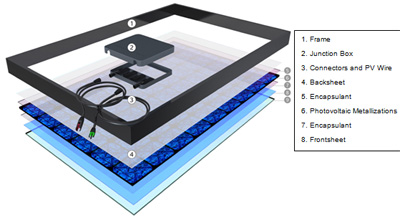In 2010, global cumulative installed photovoltaic (PV) capacity is expected to grow by at least 40 percent, with compounded annual growth estimated at 20 percent1. As demand for solar power rises, SABIC Innovative Plastics is helping to drive the viability of this much sought-after energy source into worldwide mainstream use.
Its Noryl* and Lexan* EXL resins offer customers exceptional ease in solar panel use and greater cost-efficiency, and meet stringent global regulatory standards. Applications for SABIC Innovative Plastics' materials range from PV frames to junction boxes to connectors, and the company continues to focus R&D efforts on new back sheet solutions. SABIC Innovative Plastics' materials contribute to the expansion of solar energy through system innovation, particularly by replacing metal to consolidate parts, reduce maintenance and simplify installation.
 Photovoltaic Panel Made with SABIC Innovative Plastics’ Noryl* and Lexan* EXL Resins
Photovoltaic Panel Made with SABIC Innovative Plastics’ Noryl* and Lexan* EXL Resins
"Photovoltaics is one of the most promising and dynamic energy sectors in the world - and growing," said Andy Verheijden, global product market leader, solar energy for SABIC Innovative Plastics. "To further accelerate growth, SABIC Innovative Plastics is helping to make solar power more cost-effective, practical and affordable through our range of advanced, PV-focused materials. For the future, we see a fully integrated system - with one molded part incorporating four functionalities: frame, junction box, connectors and backsheets. This is the beauty of designing in engineered thermoplastics. Our products can redefine the PV technology landscape to meet future demand."
Unique Materials to Meet Customer Needs
To achieve their goals, photovoltaic customers first need materials with high performance: flammability, weatherability, electrical and thermal performance, and corrosion resistance. Then, to encourage mainstream adoption, they need design optimization, weight reduction, extended product life and better system reliability, in order to reduce system costs and streamline installation.
SABIC Innovative Plastics offers unique materials meeting stringent IEC and UL requirements for c-Si as well as thin film PV systems components. Noryl and Lexan EXL resins are two in particular that are fast becoming the premier solutions in the world of PV materials.
Noryl* Resin
Noryl resin provides low density, dimensional stability over a wide temperature range (-40C to 140C), low warpage, excellent long-term weathering, damp heat performance with exceptional stability of up to 2,000 hours, and outstanding electrical and thermal performance. These properties make it suitable for use in PV junction boxes. Noryl resin also meets the industry's critical need for a long-lasting, outdoor-resistant material. Internal tests show that glass-filled and unfilled Noryl resins can already withstand 12,000 hours of UV exposure (which translates to approximately 10 years of outdoor weathering in Florida) with virtually no change in properties. Further testing is ongoing.
Non-halogen-based flame retardance (FR) supports compliance with a broad range of environmental standards. Further, with a low specific gravity of only 1.06, Noryl resin can help reduce weight by up to 30 percent vs. typical semi-crystalline materials, making it a material of choice for junction boxes, connectors and frames.
Lexan* EXL Resin
This specific polycarbonate copolymer resin demonstrates excellent low-temperature ductility (-60C to 140C) combined with long-term weathering and thermal performance, making it an outstanding choice for use in PV connectors.
The long-term high-temperature performance of both Noryl and Lexan EXL resins is evident by their UL Relative Thermal Index (RTI) ratings of 105C to 115C. Complete UL Yellow cards are available for both products, demonstrating compliance with requirements such as UL94 V-0, CTI class, f1 and 5V-A ratings.
During processing Noryl and Lexan EXL resins demonstrate stability and high productivity when compared to metal or semi-crystalline plastics, and achieve cycle time reductions up to 20 percent.
Other Promising Materials
Ultem* resins and LNP* specialty compounds are also being used for internal junction box parts and special connectors. Temperatures in these applications may go up to 180C or beyond and dimensional stability requirements are even more stringent. Commercial grades of Ultem resin and LNP compounds have been implemented successfully in PV applications from key industry players.